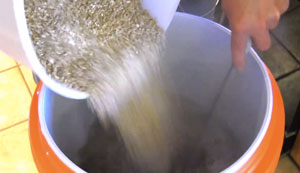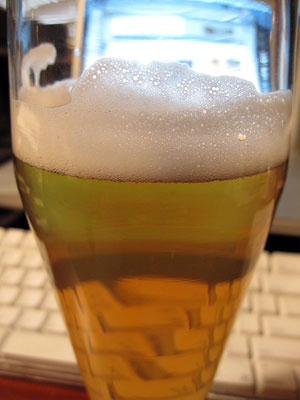This is a detailed description of the recipe I posted in my story on Easy Lager Chilling in January. Simple to brew, but very tasty.
Lager brewing can be intimidating for the brewer who has only brewed ales – at least that’s the way it was with me. Ales are fairly forgiving; ale fermentation temperatures are easier to maintain than their colder lager cousins, and there is a fear that the lager yeast either won’t get started or won’t get finished when it’s pitched.
Add into the equation decoction mashing, step mashing, and other “traditional” techniques that seem to go hand-in-hand with lager brewing. If you don’t go all the way, then you’re cheating somehow, right?
Brewing a very tasty and satisfying lager beer doesn’t have to be complicated or intimidating. This recipe and brew day is a great example. The recipe itself is a single malt and single hop (SMASH) beer. The technique is a single-temperature infusion mash. The hardest part is chilling the wort down to lager pitching temperature, but with the steps in my Easy Lager Chilling story, it’s . . . easy.
I started with 20 quarts (19 L) of strike water at 162 °F (72.2 °C) in my cylindrical cooler mash tun. To that, I added 11 pounds (4.9 kilograms) of German Pilsner malt. I rested for one hour at 152 °F (66.6 °C).
This was a batch sparge, so I collected my first runnings and added 16 quarts (15 L) of 170 °F (76.6 °C) water. After stirring the mash, recirculating the wort, and collecting my second runnings, I had a pre-boil volume of 7.5 gallons (28 L).
Since Pilsner malt is so lightly kilned, it requires a longer boil time to help drive off precursors of dimethyl sulfides (DMS), which would give the beer a “cooked corn” flavor. A little DMS character is acceptable in Pilsners, but too much is considered a flaw. So, once my wort came up to a boil, I set my timer for 90 minutes.
At the beginning of the boil, I tossed in 2.0 ounces (56 grams) of Czech Saaz hops for bittering. An hour and a half later, I put an additional 1.0 ounce (28 grams) at flameout.
I began the chilling process (detailed in the aforementioned Easy Chilling article). While the wort was coming down in temperature, I rehydrated two packages of Saflager S-23 lager yeast. To do this, I boiled a cup or so of filtered water for ten minutes to sanitize. In an ice bath, I brought the water down to slightly lower than my targeted pitching temperature, 50 °F (10 °C), and added the yeast. In my mind, pitching the yeast into relatively warmer wort would be more likely to wake them up instead of putting them to sleep.
After reaching my target pitching temperature, I added the yeast solution, shook the fermenter to aerate for four minutes, and set the carboy in my 50 °F (10 °C) basement.
The yeast was happy at that temperature. I let it work there for two weeks. After that, I moved the fermenter upstairs into a relatively warmer bathroom to do a diacetyl rest. This ensures the yeast has plenty of opportunity to clean up dactyl compounds that would give the beer a butterscotch flavor (definitely not desirable).
After the diacetyl rest, I racked to secondary and moved the fermenter to my kegerator, which is regulated by an electronic controller. Over three days, I slowly ramped the temperature down to my lagering temperature of 40 °F (4.4 °C). There it sat for an additional two weeks.
For the final step, I transferred the beer to a keg and let it lager further in the kegerator, while sampling diligently every now and then for quality monitoring purposes. That’s it – easy peasy.
With an original gravity of 1.048 and a final gravity of 1.012, this beer weighs in at 4.8% ABV. It is pale, crisp, and very satisfying. And nobody has to know the work I didn’t do.




Now I have a way to brew my beer at home. My best friend loves beer. I am going to brew some of my own by following this blog, and I am going to gift it to him on his birthday, which is tomorrow! I hope he loves it!